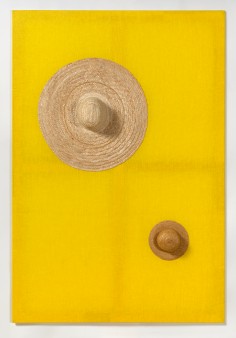Alexandre da Cunha
pseudopaintings
source: saatchigallery
Alexandre da Cunha is not the typical maker, despite the fact he operates within a sculptural field of overtly modernist tendencies. The artist intervenes into the everyday, displacing specific objects and entering them into an exhibitory realm, reorienting them as artworks. The nature of this appropriative act creates a space in which objects oscillate between strange tensions, bringing the paradoxes of contemporary art into plain sight. In da Cunha’s exploratory practice, a traditional method of figurative sculpture making is confused with found objects. His inventions emerge from a cross reading of Brazil’s neo-concrete movement and the contradictions of modernist architectural cities like Rio de Janeiro. The precariousness of urban design, which is rooted in the necessity of re-purposing found materials, is met by the minimal aesthetics of ubiquitous mass-produced objects.
.
.
.
.
.
.
.
source: cobogo
Seu trabalho é feito a partir da justaposição de objetos familiares, inicialmente não relacionados entre si, reunidos de forma única, na qual se abrem novas possibilidades de sentido. Alexandre escolhe objetos da vida cotidiana e os transforma em peças inusitadas, objetos preciosos, usando de uma sutileza e um humor que evitam a simplificação e o exagero. As peças são essencialmente esculturas – estejam elas penduradas na parede, colocadas no chão, num pedestal, pintadas, costuradas ou soldadas. O próprio artista define sua obra como “produção de imagens através da escultura” e alude ao gênero natureza-morta quando fala dos seus trabalhos. Suas peças frequentemente são o resultado de ações simples e evocam prazeres igualmente simples, ao mesmo tempo em que condensam uma complexa superposição de ideias numa forma harmoniosa.
.
.
.
.
.
.
.
source: archiefmotleysalon
Alexandre da Cunha, geboren in 1969 in Rio de Janeiro, Brazilie. Sinds 1998 woont en werkt hij in Londen. Hier studeerde hij aan de Royal College of Arts en Chelsea College of Art and Design.
Zijn werk maakt hij van dingen die je kunt tegenkomen in ieder huishouden.
Zo maakte hij Climbing Frame(2002) van moppen om mee te dweilen en afvoerbuizen en crutches van onder andere bezems, doekjes en sponzen. Hij gebruikt verwijzingen naar sportactiviteiten als metafoor voor de uitdagingen die we in ons dagelijks leven tegenkomen.
Oude autobanden ontstijgen hun lot door in werk van Da Cuhna te verworden tot unieke modernistisch beschilderde bloempotten en plastic flessen worden zo gestyled dat ze opeens heel kostbaar lijken. Het lijkt een soort metamorfose-programma zoals op t.v., alledaagse dingen worden mooi gemaakt en komen in het middelpunt van de belangstelling te staan.
Alles lijkt mogelijk, een krat kan een zwembad zijn, pool en de gestreepte stof van een tuinstoel wordt een abstract geometrisch schilderij, deck painting, gewoon uitgeknipt met een schaar.


